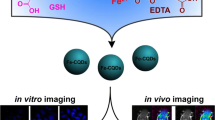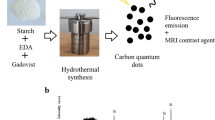Abstract
Objective
Medical imaging techniques have widely revolutionized the diagnosis and treatment of various health conditions. Among these techniques, magnetic resonance imaging (MRI) has stood out as a noninvasive and versatile tool. Now, a breakthrough innovation called “manganese-carbon dots” is poised to enhance MRI imaging and provide physicians with even greater insight into the human body.
Materials and methods
In this study, one-pot hydrothermal method was used to fabricate magneto-fluorescent carbon quantum dots using manganese citrate, urea, and Mn2+. Manganese citrateAQ3 acted as a carbon source and contrast agent. TEM,XPS, FTIR, UV–Vis, fluorescent analysis confirmed the successful synthesis of magneto-fluorescent carbon quantum dots. The MTT assay was used to study its biocompatiblity, Finallay application of itscompound for mri imaging was investigated.
Results
Characterization Techniques confirmed the succesful synthesis of product. MTT assay showed no toxicity of this product on HEK-293 cells. In addition, it exhibited high r1 relaxivity (7.4 mM–1 S−1) suggesting excellent potential of magneto-fluorescent carbon quantum dots as MRI T1 contrast agent and enabling specific imaging.
Conclusion
Based on the results obtained, the synthesized carbon quantum dots could be used as fluorescence/MRI bimodal platform for in vivo imaging.
















Similar content being viewed by others
Data availability statement
The data that support the findings of this study are available from the corresponding author, upon reasonable request.
References
Louie A (2010) Multimodality imaging probes: design and challenges. Chem Rev 110:3146–3195
Lee D-E, Koo H, Sun I-C, Ryu JH, Kim K, Kwon IC (2012) Multifunctional nanoparticles for multimodal imaging and theragnosis. Chem Soc Rev 41:2656–2672
Han L, Xia J-M, Hai X, Shu Y, Chen X-W, Wang J-H (2017) Protein-stabilized gadolinium oxide-gold nanoclusters hybrid for multimodal imaging and drug delivery. ACS Appl Mater Interfaces 9:6941–6949
Sun Y, Zhu X, Peng J, Li F (2013) Core–shell lanthanide upconversion nanophosphors as four-modal probes for tumor angiogenesis imaging. ACS Nano 7:11290–11300
Najdian A, Amanlou M, Beiki D, Bitarafan-Rajabi A, Mirzaei M, Ardestani MS (2022) Amino-modified-silica-coated gadolinium-copper nanoclusters, conjugated to AS1411 aptamer and radiolabeled with technetium-99 m as a novel multimodal imaging agent. Bioorg Chem 125:105827
Kim J, Piao Y, Hyeon T (2009) Multifunctional nanostructured materials for multimodal imaging, and simultaneous imaging and therapy. Chem Soc Rev 38:372–390
Chi C, Du Y, Ye J, Kou D, Qiu J, Wang J, Tian J, Chen X (2014) Intraoperative imaging-guided cancer surgery: from current fluorescence molecular imaging methods to future multi-modality imaging technology. Theranostics 4:1072
Hauser SB, Kockro RA, Actor B, Sarnthein J, Bernays R-L (2016) Combining 5-aminolevulinic acid fluorescence and intraoperative magnetic resonance imaging in glioblastoma surgery: a histology-based evaluation. Neurosurgery 78:475–483
Tuerhong M, Yang XU, Xue-Bo YIN (2017) Review on carbon dots and their applications. Chinese J Anal Chem 45:139–150
Jorns M, Pappas D (2021) A review of fluorescent carbon dots, their synthesis, physical and chemical characteristics, and applications. Nanomater (Basel, Switzerland). https://doi.org/10.3390/nano11061448
Wang J, Qiu J (2016) A review of carbon dots in biological applications. J Mater Sci 51:4728–4738
Liu Y, Huang H, Cao W, Mao B, Liu Y, Kang Z (2020) Advances in carbon dots: from the perspective of traditional quantum dots. Mater Chem Front 4:1586–1613
Kang Z, Lee S-T (2019) Carbon dots: advances in nanocarbon applications. Nanoscale 11:19214–19224
Wang B, Song H, Qu X, Chang J, Yang B, Lu S (2021) Carbon dots as a new class of nanomedicines: opportunities and challenges. Coord Chem Rev 442:214010
Li S, Li L, Tu H, Zhang H, Silvester DS, Banks CE, Zou G, Hou H, Ji X (2021) The development of carbon dots: From the perspective of materials chemistry. Mater Today 51:188–207
Ghoreishi SM, Najdian A, Yadegari S, Seyedhamzeh M, Etemadzade M, Mirzaei M, Hadadian S, Alikhani Z, Ardestani MS (2020) The Use of Carbon Quantum Dot as Alternative of Stannous Chloride Application in Radiopharmaceutical Kits. Contrast Media Mol Imag 2020:1–11
Liu J, Li R, Yang B (2020) Carbon dots: A new type of carbon-based nanomaterial with wide applications. ACS Cent Sci 6:2179–2195
Liu ML, Bin CB, Li CM, Huang CZ (2019) Carbon dots: synthesis, formation mechanism, fluorescence origin and sensing applications. Green Chem 21:449–471
Jia Q, Zhao Z, Liang K, Nan F, Li Y, Wang J, Ge J, Wang P (2020) Recent advances and prospects of carbon dots in cancer nanotheranostics. Mater Chem Front 4:449–471
Li Z, Wang L, Li Y, Feng Y, Feng W (2019) Frontiers in carbon dots: design, properties and applications. Mater Chem Front 3:2571–2601
Chung YJ, Kim J, Park CB (2020) Photonic carbon dots as an emerging nanoagent for biomedical and healthcare applications. ACS Nano 14:6470–6497
Li X, Fu Y, Zhao S, Xiao J, Lan M, Wang B, Zhang K, Song X, Zeng L (2022) Metal ions-doped carbon dots: Synthesis, properties, and applications. Chem Eng J 430:133101
Liu Y, Zhi X, Hou W, Xia F, Zhang J, Li L, Hong Y, Yan H, Peng C, de la Fuentea JM (2018) Gd 3+-Ion-induced carbon-dots self-assembly aggregates loaded with a photosensitizer for enhanced fluorescence/MRI dual imaging and antitumor therapy. Nanoscale 10:19052–19063
Ji D-K, Reina G, Liang H, Zhang D, Guo S, Ballesteros B, Menard-Moyon C, Li J, Bianco A (2021) Gadolinium-incorporated carbon nanodots for T 1-weighted magnetic resonance imaging. ACS Appl Nano Mater 4:1467–1477
Atabaev TS (2018) Doped carbon dots for sensing and bioimaging applications: a minireview. Nanomaterials 8:342
Tiron A, Stan CS, Luta G, Uritu CM, Vacarean-Trandafir I-C, Stanciu GD, Coroaba A, Tiron CE (2021) Manganese-doped N-hydroxyphthalimide-derived carbon dots—theranostics applications in experimental breast cancer models. Pharmaceutics 13:1982
Han C, Xu H, Wang R, Wang K, Dai Y, Liu Q, Guo M, Li J, Xu K (2016) Synthesis of a multifunctional manganese(ii)–carbon dots hybrid and its application as an efficient magnetic-fluorescent imaging probe for ovarian cancer cell imaging. J Mater Chem B 4:5798–5802
Mintz KJ, Zhou Y, Leblanc RM (2019) Recent development of carbon quantum dots regarding their optical properties, photoluminescence mechanism, and core structure. Nanoscale 11:4634–4652
Zhu S, Meng Q, Wang L, Zhang J, Song Y, Jin H, Zhang K, Sun H, Wang H, Yang B (2013) Highly photoluminescent carbon dots for multicolor patterning, sensors, and bioimaging. Angew Chemie Int Ed 52:3953–3957
Yue L, Li H, Liu Q, Guo D, Chen J, Sun Q, Xu Y, Wu F (2019) Manganese-doped carbon quantum dots for fluorometric and magnetic resonance (dual mode) bioimaging and biosensing. Microchim Acta 186:1–8
Sun S, Zhao L, Wu D, Zhang H, Lian H, Zhao X, Wu A, Zeng L (2021) Manganese-doped carbon dots with redshifted orange emission for enhanced fluorescence and magnetic resonance imaging. ACS Appl Bio Mater 4:1969–1975
Dhenadhayalan N, Lin K-C, Suresh R, Ramamurthy P (2016) Unravelling the multiple emissive states in citric-acid-derived carbon dots. J Phys Chem C 120:1252–1261
Chen N, Shao C, Qu Y, Li S, Gu W, Zheng T, Ye L, Yu C (2014) Folic acid-conjugated MnO nanoparticles as a T 1 contrast agent for magnetic resonance imaging of tiny brain gliomas. ACS Appl Mater Interfaces 6:19850–19857
Shin J, Anisur RM, Ko MK, Im GH, Lee JH, Lee IS (2009) Hollow manganese oxide nanoparticles as multifunctional agents for magnetic resonance imaging and drug delivery. Angew Chemie Int Ed 48:321–324
Huang J, Xie J, Chen K, Bu L, Lee S, Cheng Z, Li X, Chen X (2010) HSA coated MnO nanoparticles with prominent MRI contrast for tumor imaging. Chem Commun 46:6684–6686
Acknowledgements
This manuscript is prepared based on PhD thesis of first author at Rasht Branch, Islamic Azad University, Rasht, Iran.
Author information
Authors and Affiliations
Corresponding author
Ethics declarations
Conflict of interest
The authors report no conflict of interest.
Ethical standards
All procedures performed in studies involving human participants were in accordance with the ethical standards of the institutional and/or national research committee (Research Ethics Committees of School of Public Health & Allied Medical Sciences–Tehran University of Medical Sciences) and with the 1964 Helsinki declaration and its later amendments.
Additional information
Publisher's Note
Springer Nature remains neutral with regard to jurisdictional claims in published maps and institutional affiliations.
Supplementary Information
Below is the link to the electronic supplementary material.
Rights and permissions
Springer Nature or its licensor (e.g. a society or other partner) holds exclusive rights to this article under a publishing agreement with the author(s) or other rightsholder(s); author self-archiving of the accepted manuscript version of this article is solely governed by the terms of such publishing agreement and applicable law.
About this article
Cite this article
Ali, V., Kefayati, H., Shafiee Ardestani, M. et al. Synthesis and evaluation of new magneto-fluorescent carbon dot based on manganese citrate for MRI imaging. Magn Reson Mater Phy 37, 139–148 (2024). https://doi.org/10.1007/s10334-023-01117-8
Received:
Revised:
Accepted:
Published:
Issue Date:
DOI: https://doi.org/10.1007/s10334-023-01117-8




